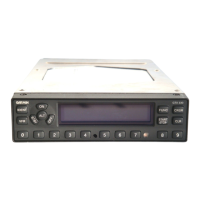190-00207-02 GTX 330/330D Installation Manual
Rev. U Page 1-1
1 GENERAL DESCRIPTION
1.1 Introduction
This manual is intended to provide mechanical and electrical information for use in the planning and
design of an installation of the GTX 330 into an aircraft. This manual is not a substitute for an approved
airframe-specific maintenance manual, installation design drawing, or complete installation data package.
Attempting to install equipment by reference to this manual alone and without first planning or designing
an installation specific to your aircraft may compromise your safety and is not recommended. The content
of this manual assumes use by competent and qualified avionics engineering personnel and/or avionics
installation specialists using standard aviation maintenance practices in accordance with Title 14 of the
Code of Federal Regulations and other relevant accepted practices. This manual is not intended for use by
individuals who do not possess the competencies and abilities set forth above.
Garmin recommends installation of the GTX 330 by a Garmin-authorized installer. To the
extent allowable by law, Garmin will not be liable for damages resulting from improper or
negligent installation of the GTX 330. For questions, please contact Garmin Aviation
Product Support at 1-888-606-5482.
1.2 Equipment Description
The Garmin GTX 330 is a panel mounted Non-Diversity Mode S Transponder while the GTX 330D is a
Diversity Mode S Transponder. The GTX 330D employs two antennas, one intended to be mounted on the
top and the other on the bottom of the aircraft. The ES option provides ADS-B extended Squitter
functionality. The design meets RTCA/DO-181C and EUROCAE ED-73B specifications.
The GTX 330 transponder is a radio transmitter and receiver that operates on radar frequencies, receiving
ground radar and TCAS interrogations at 1030 MHz and transmitting a coded response of pulses on a
frequency of 1090 MHz. The GTX 330 is equipped with IDENT capability that activates the Special
Position Identification (SPI) pulse for 18 seconds.
The GTX 330 replies to ATCRBS Mode A, Mode C and Mode S interrogations. Mode A replies consist
of any one of 4,096 codes, which differ in the position and number of pulses transmitted. Mode C replies
include framing pulses and encoded altitude. Mode S interrogations are selective. The Mode S
transponders can respond to a single directed interrogation from the ground station or another aircraft.
The GTX 330 with software version 4.01 or later, meets Mode S Enhanced Surveillance (EHS)
requirements. Mode S Enhanced Surveillance is used predominantly in European airspace. It provides
information consisting of additional aircraft parameters (see JAA NPA 20-12a) to ground radar systems.
Fixed wing aircraft that can provide the list of eight Downlink Aircraft Parameters (DAPs) listed in BDS
Registers 4,0, 5,0 and 6,0 (See
Section 1.6 Interface Summary) are considered to be Mode S EHS capable.
If these conditions cannot be met the aircraft will not be considered EHS capable. Compliance with
Enhanced Surveillance may require additional interface between aircraft systems and the GTX 330.
The GTX 330 is a Level 2 transponder, providing downlink of aircraft information. Ground stations can
interrogate Mode S Transponders individually using a 24-bit ICAO Mode S address, which is unique to the
particular aircraft. In addition, ground stations may interrogate a GTX 330 for its Transponder data
capability and the aircraft's Flight ID, which may be the registration number or other call sign. The
GTX 330 makes the maximum airspeed capability (set via configuration pages, see Section 5) available to
TCAS systems on-board nearby aircraft to aid in the determination of TCAS advisories.
In addition to displaying the code, reply symbol and mode of operation, the GTX 330 screen displays
pressure altitude, density altitude, temperature, and timer functions, depending on equipment connections

